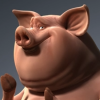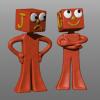-
Posts
179 -
Joined
-
Last visited
wilson66's Achievements
-
Nice to see the Photoshop-like masking implemented. Doesn't work as I would expect it though. Assigning the mask to the paint layer, then painting the mask with black does nothing, it does not hide the layer as you would expect it to do. It paints on the mask (changing mask opacity from default 0 reveals this), but that has no effect on the layer the mask is assigned to. Clearification needed.
-

3DCoat 2024 UI suggestions
wilson66 replied to Carlosan's topic in New Releases, Bugs Reports & Development Discussion
Tested new beta, and wanted to post exactly about the problem with the new vertical activity bar as digman above. Pop-ups of the new activity bar should not overlap the activity bar itself, this makes navigation really awkward. The buttons of the activity bar should be visible at all times (move pop-ups to the left so buttons are still visible). Making the activity bar a floating panel (as digman suggested) could be a good alternative idea also. -
When I opened the file today, vertex colors for most of the objects were simply gone. On some areas they were still visible, for whatever reason. No idea whats going on here, because vertex colors on all objects were clearly visible yesterday when I closed the file. Whatever, last nail in the coffin, those missing features (other thread), and strange hick-ups like disappearing vertex colors that makes you lose work, really keep me from wanting to invest a lot of time into the application at all. Wanted to give 3D Coat another try, but this is not convincing for me. Back to ZBrush it is.
-
I can see the vertex colors on the object in voxel mode (before the separation), and they are kept when switching between voxel and surface modes. They are only lost in the newly separated parts. I can't see why it should not be possible to transfer them to a separated voxel object as well, its just not implemented in the tool I suspect. It would be way faster to just do the separations in voxel mode, instead of having to rely on the surface mode booleans that love to produce invalid geometry/ pieces of geometry floating around that need to be cleaned up. Parts are not disconnected, so "separate disconnected parts" will not work out.
-
I have a character that I sculkpted quite a while ago in ZBrush, and that is simply a single object (no separate parts). I would like to separate it into multiple objects in 3D Coat (like, separate the legs from the body ect). First thing I noticed is that 3DCoat does not seem to be able to separate parts of the geometry in voxel mode and keep vertex colors. When I separate in voxel mode, vertex colors are lost. Why? Is there a way to separate in voxel mode, and keep the vertex colors? So be it, separating in surface mode works in combination with vertex colors. Although 3D Coat doesn't cut the object in the exact area I have selected, but "forgets" small parts that I then need to clean up afterwards. At least the separated object still has the orioginal vertex colors. There are certain parts of the character that cannot be easily be extracted/ separated using simple lasso selections, or I would have to cut it into multiple parts temporarily and merge those parts again afterwards. Is there a way to mark a certain area (e.g. freeze the area using combination of lasso selection and brush tools), and then separate the frozen area into a new object? If so, how do I do it?
-
Ok, thanks. Its ZBrush for this then...
-

Baking Displacement from Hi res to low res causes artifacts
wilson66 replied to Werner_Z's question in Questions & Answers
This is the logical way to displace the unsubdivided/ low poly mesh. Because the unsubdivided mesh looks faceted so to speak, the displacement map needs to look faceted like this to produce a smooth displaced surface. The middle of each face needs to gradually be displaced more than the edges to produce a smooth result in the end. EDIT: on second thought/ look, the edges seems to be displaced more, which doesn't really make sense. Mmhm.. -
I would like to cover a model of mine with dragon scales. For that, I have sculpted one of the scales on a sphere, captured the shape (as vector displacement alpha) using the pick&paste feature, and would now like to sculpt the scales onto the surface of the actual model in stamp mode. This works great, but is it possible to auto-mask each sculpted scale? Is there an option for that somewhere? Meaning, the surface needs to be frozen automatically in the displaced area. I would like to do this to avoid unwanted additional displacement. When I put the small scales close to each other, each following scale would displace the area of the already sculpted scales further (where they overlap), I would like each scale to stay exactly as it is once it is initially sculpted. If you know what I mean..
-
I have several different Blender beta and alpha versions on my hard drive, but they were not installed using a exe-installer, they were simply extracted to a folder from a ZIP file. Installing is not necessary. Is there some way to point 3DCoat/ the applink to a specific Blender .EXE-file? Right now, when I start Blender and try to send a model to 3DCoat, nothing is transferred at all.
-
Knife tool (Retopo Room, Add Geometry section) needs to be more reliable. I'm creating a retopology, and when I use the knife tool, and want to cut multiple edges in a row (I click each single one of them, it would be nice if it would cut inbetween edges automatically), it doesn't recognize many of the exisiting edges (doesn't highlight them on mouse-over), or I need to click somewhere off away from the edge so it suddenly highlights it, and when I press ENTER, it forgets to cut half the edges I have marked. When I dare to rotate the view and the first click of the knife tool is occluded by geometry (I guess), all is lost, and the cuts it creates when I press ENTER is a mess. It seems to use screen space to do the cuts, it should do them in actual 3D space. This not fun to use as it is.
-
I'm experimenting a bit with the new voxel paint functionality, and am really liking it so far. Something I have noticed in my particular little project though is that it can be really really intricate to use the "act as vox hide" feature with relatively thin objects. What I have is a wooden plank with 2 materials of varying depth, and I am scraping away the top material using brushes with "act as vox hide" option active. Because the wooden plank is relatively thin (not very, very thin, but relatively thin, as wood planks naturally only have a certain limited depth to them), the inverted vox hide (meaning, un-hide the voxels with ALT-key pressed down) very often does the opposite of whats intended: it tears holes in the mesh (that you can look right through) instead of bringing the voxels back. I might be overlooking something here, but it only seems to be possible to use the brushes with vox hide. When I try to use e.g. the rectangle lasso, this doesn't seem to work in combination with the vox hide functionality. I am brushing and brushing away, and where the object is fairly thick already, the "vox un-hiding" works correctly, but where the object is thinner, it doesn't. It tears holes in the mesh, and I am unable to bring the voxels back in the area where the holes go right through the entire mesh. It only makes the holes even larger. Long story short, if you know what I am talking about here, there must be some way in my opinion to make hidden voxels visible again easier when there are holes in the mesh. Because you can't paint in empty space/ in areas where there are holes, it takes far too long to close the holes. If that makes any sense... EDIT: forget it, everything work ok. Just use the standard Vox Hide functionality in the Adjust category...
-
Multires sculpting doesn't work well (at all) with smoothing brushes. Might already be a known problem because its really obvious, didn't check all the postings here. Created a simple sphere as a test (didn't use multires sculpting feature before), added some bottom levels, switched to top level, sculpted something using some standard brushes, stepped down and up the levels, everything in order. As long as I don't use smoothing brush (SHIFT key). When I switch to top level, use the smoothing brush, then step down the levels, geometry is destroyed. Deep holes are produced (like some vertices merged into one vertex, then projected into the center of the object, see screenshot).







